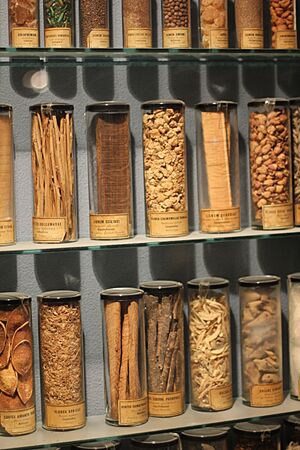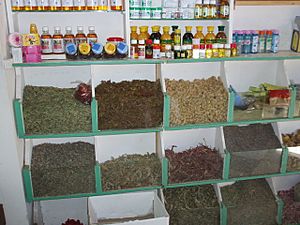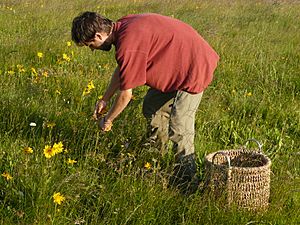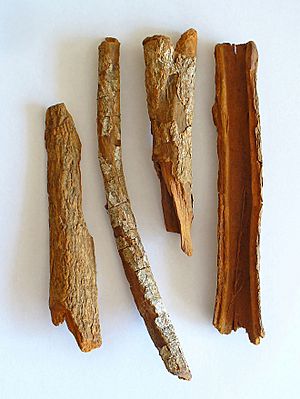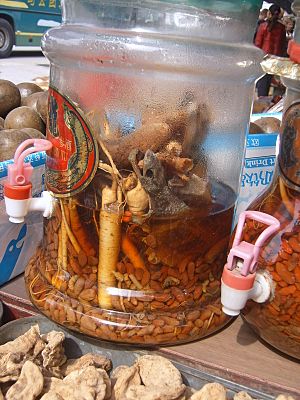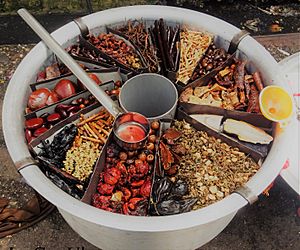Herbal medicine facts for kids
Herbal medicine is about studying and using plants for health. It's a big part of traditional medicine around the world. However, there isn't much scientific proof yet that these plant-based remedies are always safe or work well. Also, they often don't have clear rules for how pure they are or how much you should use. Herbal medicine can also include things like fungi, bee products, minerals, shells, and even some animal parts. You might also hear it called phytomedicine or phytotherapy.
Sometimes, people use raw plant or animal parts as medicines without any real proof they work. This is called paraherbalism. It's based on the idea that less processed natural things are safer or work better than manufactured medicines, but there's no scientific evidence for this.
Contents
History of Herbal Medicine
People have been using plants for medicine for a very long time, even as far back as 60,000 years ago! The first written records of herbal remedies come from the Sumerians over 5,000 years ago. They made lists of plants.
Ancient cultures often wrote about plants and their medical uses in special books called herbals. In ancient Egypt, herbs are mentioned in old medical papers and shown in tomb drawings. The Ebers Papyrus, from around 1550 BC, lists over 700 plant-based remedies.
In ancient Greece, important writers like Theophrastus wrote about plants in the 4th century BC. In China, seeds likely used for herbal medicine were found from the Shang dynasty (around 1600–1046 BC). An early Chinese medical book, Huangdi Neijing, mentions over a hundred herbs. Ancient India also used herbs a lot, often focusing on diet to treat sickness.
A famous herbal book, De Materia Medica, was written by Pedanius Dioscorides around 40–90 AD. This book was used for hundreds of years, until the 1600s!
Modern Herbal Medicine
The World Health Organization (WHO) thinks that about 80% of people in some Asian and African countries still use herbal medicine as their main healthcare.
Some modern prescription drugs actually started as herbal remedies. Examples include artemisinin, digitalis, quinine, and taxanes.
Rules and Safety Checks
In 2015, the Australian government looked at many alternative therapies, including herbalism, to see if they should be covered by health insurance. They found no clear proof that herbalism was effective.
The European Medicines Agency set up rules in 2017 to help check the safety and effectiveness of herbal products. In the United States, the National Institutes of Health funds studies on herbal compounds. They also provide information about how safe and effective many plant sources are.
Cancer Research UK stated in 2015 that there is "no strong evidence" that herbal remedies can treat or prevent cancer.
How Many People Use It?
People with long-term illnesses like cancer, diabetes, asthma, or kidney disease often use herbal remedies more. Factors like gender, age, education, and social class can also affect how often people use them.
How Herbal Preparations Are Made
Herbs can be used in many ways. The most common way is as a liquid, like a herbal tea or a plant extract.
- Herbal teas (or tisanes) are made by soaking herbs in water.
* Infusions are made with hot water, like chamomile or mint tea. * Decoctions are made by boiling harder parts like roots or bark for a long time. * Macerations are made by soaking plants in cold water for several hours.
- Tinctures are stronger extracts made by soaking herbs in alcohol. They usually have at least 25% alcohol. You can also make non-alcoholic tinctures with glycerin, but they might not work as well or last as long.
- Herbal wines and elixirs are also alcoholic extracts, usually with 12–38% alcohol.
- Extracts can be liquid or dry. Liquid extracts have less alcohol than tinctures. Dry extracts are plant materials that have been dried into a solid form, which can then be put into capsules or tablets.
The way an herbal product is made changes what chemicals are in it. For example, water-based teas will have different chemicals than oil-based extracts.
Many herbs are also put directly on the skin.
- Essential oils are strong plant extracts that are usually mixed with another oil (like olive oil) before being put on the skin. Using them straight can sometimes burn the skin.
- Salves, oils, balms, creams, and lotions are other ways to put herbs on the skin. These are often made by soaking herbs in food-grade oils for weeks or months. This helps certain plant chemicals get into the oil.
Breathing in herbal vapors, like in aromatherapy, can also be a treatment.
Is It Safe?
Just because something is "natural" doesn't always mean it's safe. Herbal medicines can have side effects. Also, if they are not made correctly, or if people don't understand how they interact with other medicines, they can be dangerous or even deadly. We need proper scientific studies to know if each plant is truly safe and effective for medical use.
Herbal remedies can also be contaminated, meaning they have unwanted or harmful substances in them. Sometimes, people might use herbal medicines instead of proven prescription drugs, which can be risky if the herbal remedy doesn't work.
Plants have natural defenses against things that might harm them, and these chemicals can sometimes be bad for humans. For example, poison hemlock and nightshade are very toxic herbs. While these are not sold to the public as herbs, some widely used herbs have also caused problems. For instance, too much licorice can cause a serious lack of potassium. Black cohosh has been linked to liver problems in some cases.
There are not many studies on how safe herbs are for pregnant women. One study found that using certain alternative medicines might lower the chances of a successful pregnancy during fertility treatment.
Some herbs that have been linked to health problems include aconite, broom, chaparral, comfrey, and certain Chinese herb mixtures. Other herbs like ginseng, goldenseal, milk thistle, senna, aloe vera juice, and St. John's wort may have long-term side effects. Kava is even banned in the European Union.
It's very important to tell your doctor if you are using any herbal remedies. Some herbs can interact with prescription or over-the-counter medicines. For example, if an herb lowers blood pressure and you take a medicine that also lowers blood pressure, your blood pressure could drop too much. Some herbs can also make blood thinners work too strongly.
In 2018, the FDA (Food and Drug Administration) in the US found that over 700 "herbal" or "natural" supplements actually contained hidden strong medicines, like unapproved antidepressants, steroids, or drugs like sildenafil.
Are Labels Accurate?
A study in 2013 found that one-third of herbal supplements tested had no trace of the herb listed on the label! Some products even had harmful substances or fillers not listed, like soy, wheat, or black walnut, which can be allergens. One bottle labeled as St. John's wort actually contained a laxative called Alexandrian senna.
In 2014, researchers in Australia found that almost 20% of herbal remedies were not properly registered. They also found that nearly 60% of products had ingredients that didn't match what was on the label.
In 2015, the New York Attorney General told four big US stores (GNC, Target, Walgreens, and Walmart) to stop selling certain herbal supplements. Tests showed that many of these products were mislabeled and could be dangerous.
People Who Practice Herbalism
In some countries, herbalists need to have special training and meet certain education standards. However, these rules can be different from place to place. For example, in Australia, the training for herbalists used to vary a lot. In the UK, universities offer degrees in herbal medicine. In the US, there are no state licenses for herbalists, but there are rules about selling herbs as cures for medical conditions without a license.
Rules by Governments
The World Health Organization (WHO) published guidelines in 1998 to help countries set quality standards for herbal materials.
In the European Union, herbal medicines are regulated by a special committee.
In the United States, herbal remedies are seen as "dietary supplements" by the Food and Drug Administration (FDA). Manufacturers don't have to prove their products are safe or effective as long as they don't claim to cure diseases. However, the FDA can remove a product from sale if it proves to be harmful.
Canada has its own rules, requiring a special number on the label of licensed herbal medicines.
Some herbs, like cannabis and coca, are banned in most countries. However, cannabis is legal for medical use in some places. Ephedra, another herb, has been banned as a dietary supplement in the US since 2004.
Paraherbalism
Paraherbalism is when people use raw plant or animal parts as medicines or health boosters without scientific proof. It's different from regular medicine because it doesn't try to find and measure the active chemicals in a plant. Instead, it's based on the wrong idea that using less processed parts of a plant is safer or works better. There's no evidence for this.
A researcher named Varro Eugene Tyler called paraherbalism "bad herbalism based on fake science." He said that paraherbalism often uses scientific words but doesn't have real scientific proof. Tyler pointed out ten common mistakes in paraherbalism, such as believing that:
- There's a secret plan to hide safe and effective herbs.
- Herbs can't cause harm.
- Whole herbs are better than chemicals taken from plants.
- Herbs are better than drugs.
- The shape of a plant tells you what it's good for.
- Making something weaker makes it stronger (like in homeopathy).
- Stars and planets affect how herbs work.
- Testing on animals doesn't show how herbs affect humans.
- Stories from people are enough to prove an herb works.
- God made herbs to cure diseases.
Tyler said that none of these beliefs are based on facts.
Traditional Systems Around the World
Africa
In Africa, up to 80% of people use traditional medicine as their main healthcare.
Americas
Native Americans used about 2,500 different plant types out of the 20,000 native to North America. In the Andes mountains, people still use the San Pedro cactus as part of their healing practices, a tradition that goes back thousands of years.
China
Some researchers have studied ancient Chinese medical texts using modern science. In 1972, a chemist named Tu Youyou found the anti-malarial drug artemisinin from sweet wormwood, a plant used in traditional Chinese medicine for fevers.
India
In India, Ayurvedic medicine often uses complex mixtures with 30 or more ingredients, including some that have gone through special "alchemical processing." These are chosen to balance the body's energies. In places like Ladakh and Tibet, the Tibetan Medical System is common. This system uses over 337 types of medicinal plants. Old Indian books like the Vedas also mention treating diseases with plants.
Indonesia
In Indonesia, especially among the Javanese people, traditional herbal medicine called jamu may have started about 1300 years ago. Old carvings on the Borobudur temple show people grinding herbs and selling herbal drinks. An old book from around 1700 lists 3,000 jamu recipes. While it might have been influenced by Indian medicine, Indonesia has many unique plants not found in India. Jamu practices can differ from region to region and often include ingredients from animals like honey and eggs.
Why People Believe in Herbal Medicine
Herbalists often use extracts from plant parts like roots or leaves. They believe that plants develop special chemicals to protect themselves from things like radiation or germs. They think these protective chemicals can also be helpful for humans.
How Animals Use Plants
Zoopharmacognosy
 In Spanish: Herbología para niños Some traditional healers say they learned about herbs by watching sick animals. They noticed that sick animals would eat bitter herbs they normally wouldn't touch. Scientists have seen this too, with animals like chickens, sheep, butterflies, and chimpanzees. Eating different plants can help animals get rid of parasites in their bodies. Sick animals often look for plants that have many secondary metabolites, which are chemicals like tannins and alkaloids.
In Spanish: Herbología para niños Some traditional healers say they learned about herbs by watching sick animals. They noticed that sick animals would eat bitter herbs they normally wouldn't touch. Scientists have seen this too, with animals like chickens, sheep, butterflies, and chimpanzees. Eating different plants can help animals get rid of parasites in their bodies. Sick animals often look for plants that have many secondary metabolites, which are chemicals like tannins and alkaloids.


